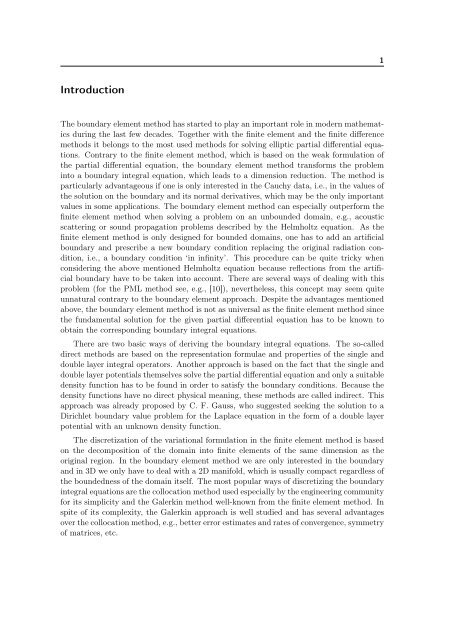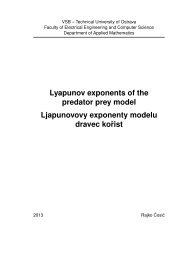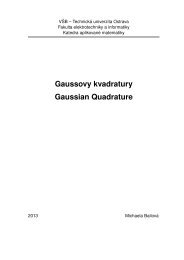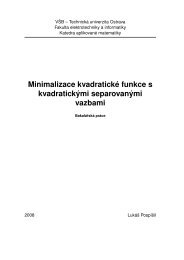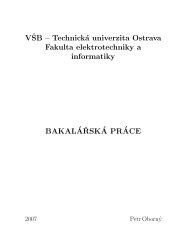The Boundary Element Method for the Helmholtz Equation ... - FEI VÅ B
The Boundary Element Method for the Helmholtz Equation ... - FEI VÅ B
The Boundary Element Method for the Helmholtz Equation ... - FEI VÅ B
Create successful ePaper yourself
Turn your PDF publications into a flip-book with our unique Google optimized e-Paper software.
1Introduction<strong>The</strong> boundary element method has started to play an important role in modern ma<strong>the</strong>maticsduring <strong>the</strong> last few decades. Toge<strong>the</strong>r with <strong>the</strong> finite element and <strong>the</strong> finite differencemethods it belongs to <strong>the</strong> most used methods <strong>for</strong> solving elliptic partial differential equations.Contrary to <strong>the</strong> finite element method, which is based on <strong>the</strong> weak <strong>for</strong>mulation of<strong>the</strong> partial differential equation, <strong>the</strong> boundary element method trans<strong>for</strong>ms <strong>the</strong> probleminto a boundary integral equation, which leads to a dimension reduction. <strong>The</strong> method isparticularly advantageous if one is only interested in <strong>the</strong> Cauchy data, i.e., in <strong>the</strong> values of<strong>the</strong> solution on <strong>the</strong> boundary and its normal derivatives, which may be <strong>the</strong> only importantvalues in some applications. <strong>The</strong> boundary element method can especially outper<strong>for</strong>m <strong>the</strong>finite element method when solving a problem on an unbounded domain, e.g., acousticscattering or sound propagation problems described by <strong>the</strong> <strong>Helmholtz</strong> equation. As <strong>the</strong>finite element method is only designed <strong>for</strong> bounded domains, one has to add an artificialboundary and prescribe a new boundary condition replacing <strong>the</strong> original radiation condition,i.e., a boundary condition ‘in infinity’. This procedure can be quite tricky whenconsidering <strong>the</strong> above mentioned <strong>Helmholtz</strong> equation because reflections from <strong>the</strong> artificialboundary have to be taken into account. <strong>The</strong>re are several ways of dealing with thisproblem (<strong>for</strong> <strong>the</strong> PML method see, e.g., [10]), never<strong>the</strong>less, this concept may seem quiteunnatural contrary to <strong>the</strong> boundary element approach. Despite <strong>the</strong> advantages mentionedabove, <strong>the</strong> boundary element method is not as universal as <strong>the</strong> finite element method since<strong>the</strong> fundamental solution <strong>for</strong> <strong>the</strong> given partial differential equation has to be known toobtain <strong>the</strong> corresponding boundary integral equations.<strong>The</strong>re are two basic ways of deriving <strong>the</strong> boundary integral equations. <strong>The</strong> so-calleddirect methods are based on <strong>the</strong> representation <strong>for</strong>mulae and properties of <strong>the</strong> single anddouble layer integral operators. Ano<strong>the</strong>r approach is based on <strong>the</strong> fact that <strong>the</strong> single anddouble layer potentials <strong>the</strong>mselves solve <strong>the</strong> partial differential equation and only a suitabledensity function has to be found in order to satisfy <strong>the</strong> boundary conditions. Because <strong>the</strong>density functions have no direct physical meaning, <strong>the</strong>se methods are called indirect. Thisapproach was already proposed by C. F. Gauss, who suggested seeking <strong>the</strong> solution to aDirichlet boundary value problem <strong>for</strong> <strong>the</strong> Laplace equation in <strong>the</strong> <strong>for</strong>m of a double layerpotential with an unknown density function.<strong>The</strong> discretization of <strong>the</strong> variational <strong>for</strong>mulation in <strong>the</strong> finite element method is basedon <strong>the</strong> decomposition of <strong>the</strong> domain into finite elements of <strong>the</strong> same dimension as <strong>the</strong>original region. In <strong>the</strong> boundary element method we are only interested in <strong>the</strong> boundaryand in 3D we only have to deal with a 2D manifold, which is usually compact regardless of<strong>the</strong> boundedness of <strong>the</strong> domain itself. <strong>The</strong> most popular ways of discretizing <strong>the</strong> boundaryintegral equations are <strong>the</strong> collocation method used especially by <strong>the</strong> engineering community<strong>for</strong> its simplicity and <strong>the</strong> Galerkin method well-known from <strong>the</strong> finite element method. Inspite of its complexity, <strong>the</strong> Galerkin approach is well studied and has several advantagesover <strong>the</strong> collocation method, e.g., better error estimates and rates of convergence, symmetryof matrices, etc.


